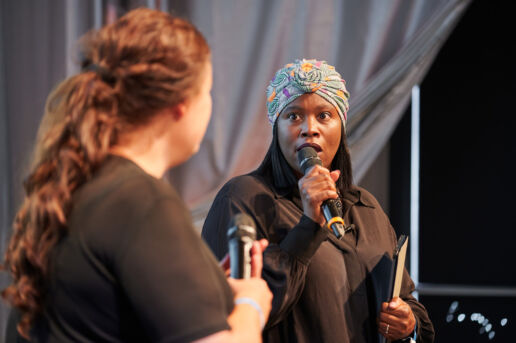The Textile Industry: What to Expect in the Next Five Years
Guest post by Muchaneta ten Napel, Founder and CEO, Shape Innovate
The textile industry has undergone remarkable changes, shifting from the use of traditional handlooms to state-of-the-art factories that produce enormous amounts of textiles and clothing. With the quickening pace of technological advancements, shifting consumer preferences, and evolving global trends, the landscape of the textile industry is on the brink of even more significant transformations in the upcoming five years.

Sustainability, No Longer a Buzzword
Sustainability has evolved from a catchphrase to a prerequisite in the textile sector. The rising consciousness of consumers regarding their environmental impact has compelled textile producers to adopt eco-friendly practices. As a result, the forthcoming half-decade is expected to herald an era where sustainability is the rule, not the exception.
The focus will be reducing hazardous chemicals, water, and energy in textile production. The industry will place greater emphasis on circular production methods and using recycled materials. Brands will strive to decrease their carbon footprint while maintaining the quality and style of their products, ensuring their entire supply chain adheres to sustainability standards.
Technology, A Key Driver
Technological innovation, a key industry driver, will further shape production processes over the next five years. Automation, artificial intelligence (AI), and the Internet of Things (IoT) will redefine production efficiency. Automation will enhance efficiency, reduce manual labour, and minimise production errors, leading to quicker turnarounds, amplified production capacity, and cost reduction.
AI will enable trend prediction, production optimisation, and quality control enhancement. Textile producers will leverage AI tools to analyse data and make informed sourcing, manufacturing, and distribution decisions. By connecting devices and systems, IoT will provide the following:
- Real-time control and monitoring of production processes.
- Thus improving quality control.
- Reducing waste.
- Boosting productivity.
Demand for luxury and premium textile products will rise over the next five years. An increase in consumer financial stability and an expanding middle class in emerging markets like China and India will drive this trend. In addition, the shift in consumer behaviour due to the COVID-19 pandemic towards prioritising comfort, quality, and durability over fast fashion will likely persist.
The Rise of Local Production
The pandemic also highlighted global supply chains’ vulnerability, causing production and delivery disruptions. The coming years will see a rise in local production as brands seek to reduce dependency on foreign suppliers. This shift towards local production will bring quicker turnarounds, lower transportation costs, reduced carbon footprint, and greater control over the supply chain. It will also stimulate local economies by creating job opportunities and nurturing local textile industries.
However, local production comes with challenges, including potentially higher costs than overseas production and the need for a skilled workforce. Nevertheless, the brands that successfully adapt to these shifts and meet evolving consumer needs will flourish in the upcoming years. In addition, the textile industry’s transformation presents an opportunity to address long-standing issues such as environmental sustainability, ethical production, and supply chain transparency, promising an exciting future.
In conclusion, the textile industry is poised for a significant evolution in the next five years, propelled by consumer behaviour, global trends, and technological advancements.
The textile industry is poised for a significant transformation in the next five years. Its evolution presents an opportunity to address long-standing challenges such as environmental sustainability, ethical production, and supply chain transparency.
All in all, it is an exciting time for the textile industry, and the next five years will undoubtedly shape its future.
Are you interested in more in-depth facts and figures on the new textile economy?
Visit the Shape Innovate Lounge in H5 | 04 or attend the mini-lectures in the Keyhouse.

About the author
Founding editor-in-chief of Shape Innovate, Muchaneta has worked in the fashion industry for over 14 years. She is currently one of the leading influencers speaking and writing about the merger of fashion with technology and wearable technology.
Muchaneta ten Napel | m@shapeinnovate.com
THIS ALSO MIGHT BE INTERESTING FOR YOU
The Power of Data: Understanding How Data Tackles Challenges in the Textile Industry
31. January 2025
Data might feel intimidating for the fashion and textile industry, but it holds the power to unlock transparency, boost efficiency, and spark innovation...
MUNICH FABRIC START & BLUEZONE – Essence of Innovative Design & Smart Strategies in Challenging Times
24. January 2025
FLORESCENCE describes the phase in which plants reach their full bloom and is used as a general metaphor for the process of blossoming.
Additionals Trends Spring.Summer 26 – Part 8
20. January 2025
Trims and packaging are branding items we shouldn’t take for granted – they are a signature that transforms the ordinary into the unforgettable.
SPRING.SUMMER 26 FABRIC HIGHLIGHTS & MATERIAL NOVELTIES – PART V
19. January 2025
Their philosophy,“Drawing art with threads, conveying emotions through embroidery,” ensures every product is not just visually stunning but also deeply meaningful.
The Source Collection’s News at MUNICH FABRIC START
19. January 2025
Neutral sand mélange and off-white jacquards set a sophisticated tone, while soft yarn jersey pieces bring effortless comfort.
Additionals Trends Spring.Summer 26 – Part 7
18. January 2025
Whether haptic or visual - it's all about contrasts, which in combination provide impulses and demand new ways of thinking. Perfect for brands that want to make bold statements!
Kantamanto Social Club
17. January 2025
The mission of Kantamanto Social Club is clear: to empower communities in the Global South. It aims to shine a spotlight on communities, particularly those whose circular and regenerative practices have been undervalued for too long.
Curiosity, Courage and Craftmanship
17. January 2025
The projects I selected this season challenge us to rethink everything from raw materials to end products and production processes, whilst emphasising on sustainability as an ongoing dialogue.
Cartoon – Fashion for courage, joie de vivre and self-realisation
16. January 2025
Welcome to Cartoon - your invitation to a life full of courage, joie de vivre and self-realisation!
The Source Collection’s News: EAST
16. January 2025
Fashion is not only about following trends, but also about expressing your creativity and personality.











